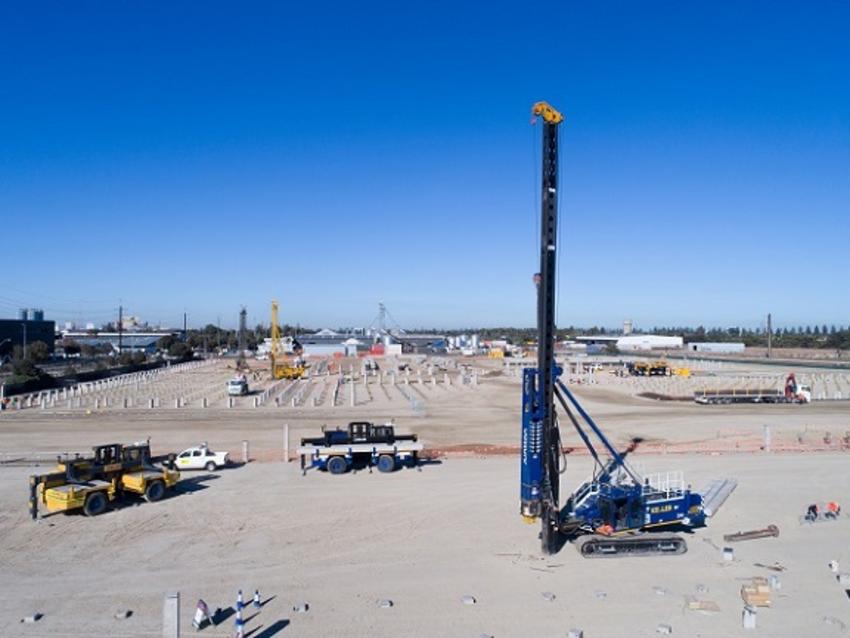The Australian government is investing over a billion dollars in the nation’s shipyards to develop the next generation of naval vessels. The Osborne naval shipbuilding precinct is one such place and it’s here that Keller Australia is entrusted with a major piling contract for the shipyard expansion project.

Osborne, located some 25km north of the Adelaide central business district, will be home to one of Australia’s largest naval projects, the A$35 billion future frigate programme
To deliver these key projects the shipyard is undergoing a huge expansion, including the development of three giant, hangar-like buildings totalling around 50,000m2. While the buildings themselves are essentially lightweight shelters, the shipyard building foundations involve large concrete platforms supported on piles.
In 2008 Keller successfully installed piles – driven cast-in-situ piles (DCIS, also known as Frankipiles) – for an adjacent platform. The same pile type has been adopted for the current shipyard expansion works now underway, along with the use of a precast concrete, driven pile solution.
Technically challenging
“The main contractor Lend Lease – who we’ve worked for many times – needed a foundations contractor with experience in this part of Adelaide, who could deliver a design-and-construct project, meet the strict pile-performance criteria and meet what is a fast-tracked programme,” explains Engineering Manager Ken Wright.
“From a technical point of view, the pile loads are relatively high, settlement performance criteria are stringent and the buildings are going to be situated close to the Port Adelaide River where the top 10m of soil is weak. The project required a piling solution which provided a superior performance and also minimised spoil generation across the project site. A DCIS pile solution was chosen not only because of its superior performance but also because it’s a spoil-free solution, which reduced project costs and risks associated with spoil generation and handling on the project.
“Due to programme constraints and limited local plant resource, we explored a number of alternative design solutions for the more lightly loaded piles. These included driven precast, rigid inclusions and continuous flight auger piles to supplement the DCIS piles and give our client confidence that we would meet their schedule.”
Extensive testing
After much analysis of design and constructibility, taking into account cost and schedule, Keller determined the optimum solution to be a hybrid of 2,000 traditional DCIS and 2,500 driven precast concrete piles. Working closely with Lend Lease, Keller demonstrated that the solution would meet the project objectives in terms of technical performance, quality, programme and cost, and was awarded the contract in December 2017.
The fact that Ken, along with Project Manager Paul Camilleri and Site Engineer Jared Fetherston, had worked on the previous project for Keller in 2008, provided Keller management support to the project and greater certainty in achieving the set outcomes.
Starting on site in March 2018, the project required an extensive testing regime, including full-scale static compression load tests, static lateral load tests, dynamic pile testing and integrity testing to ensure the piles would perform as intended by Keller’s design – and meet the project’s ‘future proof’ requirements.
“We’ve also taken the opportunity to perform some additional testing, adding strain gauges on the base and shaft of several test piles, which will help us refine and improve our pile designs for future projects,” Ken adds.
Innovation in production and safety
To meet programme demand on such a large project Keller is utilising five rigs. And with the site located far from Keller’s existing pile-casting facilities, the team has taken the innovative step of setting up a large-scale, on-site casting yard, which produces about 600 metres of pile segments a day.
The pile segments are transferred from the yard using a Keller-designed side loader. This machine safely lifts and transports several segments of pile at a time and eliminates the need for a crane and dogman to pick up and move the piles, greatly reducing safety risks on site and local transport costs.
At press time, the team is nearing the end of the project, which is going well.
“I believe we’ve shown that we have the knowledge and experience to design and deliver a large, complex and nationally significant project,” Ken says. “We’ve been able to provide a combination of products that meets the project requirements, set up a remote casting yard and carry out extensive testing to demonstrate surety of our design and quality of our products.”